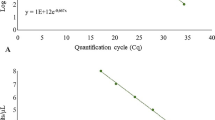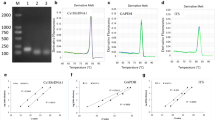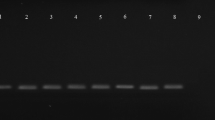Abstract
Commercial areas containing Eucalyptus plantations have expanded in recent years due to increased demands for pulp, paper and bioenergy. One of the threats that can reduce Eucalyptus production is the eucalyptus rust disease caused by Austropuccinia psidii, a biotrophic fungus that affects a broad range of Myrtaceae. An accurate diagnosis tool for the early detection of rust disease could be useful in breeding programs for selection of resistant plants against rust, in phytosanitary purposes or in rust epidemics studies. The aim of the present work was to develop a SYBR Green-based quantitative real-time PCR (qPCR) assay for the early detection and quantification of A. psidii in Eucalyptus grandis leaves. Three sets of primers based on the A. psidii ribosomal DNA intergenic space region (IGS), beta-tubulin and elongation factor genes were designed and evaluated. The assays using the IGS primer set resulted in the highest detection efficiency, detecting a lower limit of 0.5 pg of A. psidii DNA. Under artificial inoculation in plants, A. psidii was detected immediately after pathogen inoculation until 240 h post-inoculation using qPCR. In field validation of the method, A. psidii was detected using qPCR in naturally infected leaves with or without rust symptoms. This easy and fast method can be used for an efficient detection of A. psidii in E. grandis leaves. The implications of this tool for rust studies are discussed below.





Similar content being viewed by others
References
Alaei, H., Baeven, S., Maes, M., Hofte, M., & Heungens, K. (2009). Molecular detection of Puccinia horiana in Chrysanthemum morifolium through conventional and real time PCR. Journal of Microbiological Methods, 76, 136–145.
Anderson, J. B., & Stasovski, E. (1992). Molecular phylogeny of Northern hemisphere species of Armillaria. Mycologia, 84, 505–516.
Baldauf, S. L., & Doolittle, W. F. (1997). Origin and evolution of the slime molds. Proceedings of the National Academy of Sciences, 94, 12007–12012.
Baskarathevan, J., Taylor, R. K., Ho, W., McDougal, R. L., Shivas, R. G., & Alexander, B. J. R. (2016). Real-time PCR assays for the detection of Puccinia psidii. Plant Disease, 100, 617–624.
Beenken, L. (2017). Austropuccinia: a new genus name for the myrtle rust Puccinia psidii placed within the redefined family Sphaerophragmiaceae (Pucciniales). Phytotaxa, 297, 53–61.
Bilodeau, G. J., Lévesque, C. A., De Cock, A. W. A. M., Duchaine, C., Brière, S., Uribe, P., Martin, F. N., & Hamelin, R. C. (2007). Molecular detection of Phytophthora ramorum by real-time polymerase chain reaction using TaqMan, SYBR Green, and molecular beacons. Phytopathology, 97, 632–642.
Carnegie, A. J. (2015). First report of Puccinia psidii (Myrtle Rust) in Eucalyptus plantations in Australia. Plant Disease, 99, 161.
Carnegie, A. J., Lidbetter, J. R., Walker, J., Horwood, M. A., Tesoriero, L., Glen, M., & Priest, M. (2010). Uredo rangelii, a taxon in the guava rust complex, newly recorded on Myrtaceae in Australia. Australasian Plant Pathology, 39, 463–466.
Coutinho, T. A., Wingfield, M. J., Alfenas, A. C., & Crous, P. W. (1998). Eucalyptus rust: a disease with the potential for serious implications. Plant Disease, 82, 819–825.
Covarelli, L., Beccari, G., Steed, A., & Nicholson, P. (2012). Colonization of soft wheat following infection of the stem base by Fusarium culmorum and translocation of deoxynivalenol to the head. Plant Pathology, 61, 1121–1129.
Crouch, J. A., & Szabo, L. J. (2011). Real-time PCR detection and discrimination of the southern and common corn rust pathogens Puccinia polysora and Puccinia sorghi. Plant Disease, 95, 624–632.
Dean, R., Van Kan, J. A. L., Pretorius, Z. A., Hammond-Kosack, K. E., Di Pietro, A., Spanu, P. D., Rudd, J. J., Dickman, M., Kahmann, R., Ellis, J., & Foster, G. D. (2012). The top 10 fungal pathogens in molecular plant pathology. Molecular Plant Pathology, 13, 414–430.
Demontis, M.A., Cacciola, S.O., Orru, M., Balmas, V., Chessa, V., Maserti, B.E., Mascia, L., Raudino, F., Di San Lio, M.G, & Migheli, Q. (2008). Development of real-time PCR systems based on SYBR Green I and TaqMan technologies for specific quantitative detection of Phoma tracheiphila in infected citrus. European Journal of Plant Pathology, 120, 339–351.
Giblin, F. (2013). Myrtle rust report: New Caledonia. http://www.davar.gouv.nc/portal/page/portal/davar/librairie/fichiers/25074187.PDF. Accessed 20 July 2016.
Glass, N. L., & Donaldson, G. C. (1995). Development of primer sets designed for use with the PCR to amplify conserved genes from filamentous ascomycetes. Applied and Environmental Microbiology, 61, 1323–1330.
Glen, M., Alfenas, A. C., Zauza, E. A. V., Wingfield, M. J., & Mohammed, C. (2007). Puccinia psidii, a threat to the Australian environment and economy –a review. Australasian Plant Pathology, 36, 1–16.
Graça, R. N., Aun, C. P., Guimarães, L. M. S., Rodrigues, B. V. A., Zauza, E. A. V., & Alfenas, A. C. (2011). A new race of Puccinia psidii defeats rust resistance in eucalypt. Australasian Plant Pathology, 40, 442–447.
Grgurinovic, C. A., Walsh, D., & Macbeth, F. (2006). Eucalyptus rust caused by Puccinia psidii and the threat it poses to Australia. EPPO Bulletin, 36, 486–489.
Hayden, K. J., Rizzo, D., Tse, J., & Garbelotto, M. (2004). Detection and quantification of Phytophthora ramorum from California forests using a real-time polymerase chain reaction assay. Phytopathology, 94, 1075–1083.
Kawanishi, T., Uemastu, S., Kakishima, M., Kagiwada, S., Hamamoto, H., Horie, H., & Namba, S. (2009). First report of rust disease on ohia and the causal fungus in Japan. Journal of General Plant Pathology, 75, 428–431.
Langrell, S., Glen, M., & Alfenas, A. C. (2008). Molecular diagnosis of Puccinia psidii (guava rust) - a quarantine threat to Australian eucalypt and Myrtaceae biodiversity. Plant Pathology, 57, 687–701.
Leite, T.F. (2012). Estabelecimento de um patossistema modelo e análise da interação molecular planta-patógeno entre Eucalyptus grandis e Puccinia psidii Winter por meio da técnica de RNA-Seq. Piracicaba, Brasil: Escola Superior de Agricultura Luiz de Queiraz, University of São Paulo, PhD thesis.
Leite, T. F., Moon, D. H., Lima, A. C. M., Labate, C. A., & Tanaka, F. A. O. (2013). A simple protocol for whole leaf preparation to investigate the interaction between Puccinia psidii and Eucalyptus grandis. Australasian Plant Pathology, 42, 79–84.
Maeda, H., Fujimoto, C., Haruki, Y., Maeda, T., Kokeguchi, S., Petelin, M., Arai, H., Nishimura, I. T. H., & Takashiba, S. (2003). Quantitative real-time PCR using TaqMan and SYBR Green for Actinobacillus actinomycetemcomitans, Porphyromonas gingivalis, Prevotella intermedia, tetQ gene and total bacteria. FEMS Immunology and Medical Microbiology, 39, 81–86.
Marlatt, R. B., & Kimbrough, J. W. (1979). Puccinia psidii on Pimenta dióica in south Florida. Plant Disease Report, 3, 510–512.
McTaggart, A. R., Roux, J., Granados, G. M., Gafur, A., Tarrigan, M., Santhakumar, P., & Wingfield, M. J. (2016a). Rust (Puccinia psidii) recorded in Indonesia poses a threat to forests and forestry in South-East Asia. Australasian Plant Pathology, 45, 83–89.
McTaggart, A. R., Shivas, R. G., van der Nest, M. A., Roux, J., Wingfield, B. D., & Wingfield, M. J. (2016b). Host jumps shaped the diversity of extant rust fungi (Pucciniales). New Phytologist, 209, 1149–1158.
Muller, L. K., Lorch, J. M., Lindner, D. L., O’Connor, M., Gargas, A., & Blehert, D. S. (2013). Bat white-nose syndrome: a real-time TaqMan polymerase chain reaction test targeting the intergenic spacer region of Geomyces destructans. Mycologia, 105, 253–259.
Nath, V. S., Hegde, V. M., Jeeva, M. L., Misra, R. S., Veena, S. S., Raj, M., Unnikrishnan, S. K., & Darveekaran, S. S. (2014). Rapid and sensitive detection of Phytophthora colocasiae responsible for the taro leaf blight using conventional and real-time PCR assay. FEMS Microbiology Letters, 352, 174–183.
Pedley, K. F. (2009). PCR-based assays for the detection of Puccinia horiana on chrysanthemums. Plant Disease, 93, 1252–1258.
Quecine, M. C., Bini, A. P., Romagnoli, E. R., Andreote, F. D., Moon, D. H., & Labate, C. A. (2014). Genetic variability in Puccinia psidii populations as revealed by PCR-DGGE and T-RFLP markers. Plant Disease, 8, 16–23.
Roux, J., Greyling, I., Coutinho, T. A., Verleur, M., & Wingfield, M. J. (2013). The Myrtle rust pathogen, Puccinia psidii, discovered in Africa. IMA Fungus, 4, 155–159.
Sanzani, S. M., Li Destri Nicosia, M. G., Faedda, R., Cacciola, S. O., & Schena, L. (2014). Use of quantitative PCR detection methods to study biocontrol agents and phytopathogenic fungi and oomycetes in environmental samples. Journal of Phytopathology, 162, 1–13.
Scocco, E. A., Walcott, R. R., Jeffers, S. N., & Buck, J. W. (2013). Detection of Puccinia pelargonii-zonalis-infected geranium tissues and urediniospores. Journal of Phytopathology, 161, 341–347.
Thompson, J. D., Higgins, D. G., & Gibson, T. J. (1994). CLUSTAL W: improving the sensitivity of progressive multiple sequence alignment through sequence weighting, position-specific gap penalties and weight matrix choice. Nucleic Acids Research, 22, 4673–4680.
Tommerup, I. C., Alfenas, A. C., & Old, K. M. (2003). Guava rust in Brazil – a threat to Eucalyptus and other Myrtaceae. New Zealand Journal of Forestry Science, 33, 420–428.
Uchida, J., Zhong, S., & Killgore, E. (2006). First report of a rust disease on ‘Ohi’a caused by Puccinia psidii in Hawaii. Plant Disease, 90, 524.
Winter, G. (1884). Repertorium. Rabenhorstii fungi europaei et extraeuraopaei. Centuria XXXI et XXXII. Hedwigia, 23, 164–175.
Xavier, A. A., Alfenas, A. C., Matsuoka, K., & Hodges, C. S. (2001). Infection of resistant and susceptible Eucalyptus grandis genotypes by urediniospores of Puccinia psidii. Australasian Plant Pathology, 30, 277–281.
Yan, L., Zhang, C., Ding, L., & Ma, Z. (2008). Development of a real-time PCR assay for the detection of Cladosporium fulvum in tomato leaves. Journal of Applied Microbiology, 104, 1417–1424.
Zauza, E. A. V., Lana, V. M., Maffia, L. A., Araujo, M. M. F. C., Alfenas, R. F., Silva, F. F., & Alfenas, A. C. (2015). Wind dispersal of Puccinia psidii urediniospores and progress of eucalypt rust. Forest Pathology, 45, 102–110.
Zhuang, J. Y., & Wei, S. X. (2011). Additional materials for the rust flora of Hainan Province, China. Mycosystema, 30, 853–860.
Acknowledgments
This work was supported by Fundação de Amparo à Pesquisa do Estado de São Paulo - FAPESP (Grant 2008/50361-1, 2014/16804-4). We thank Conselho Nacional de Desenvolvimento Científico e Tecnológico (CNPq) and FAPESP for the fellowships to A.P.B. (Proc. no.140040/2012-9 and 2013/07596-6), M.C.Q. (Proc. no. 2010/50445-0) and T.M.S. We thank Dr. Esteban Gonzalez (FuturaGene Corporation) for providing the Eucalyptus A. psidii populations and other facilities as well as Dr. Janice Uchida, Dr. Guus Bakkeren and UNESP/FCAV for providing DNA and urediniospores from different species of Puccinia or Austropuccinia for the specificity assays. We also thank Sarina Tsui and Thiago Gonçalves de Oliveira for helping in field sampling and Dr. Tsai Siu Mui and Dr. Danielle Gregorio Gomes Caldas for providing the structure for the reproducibility tests.
Author information
Authors and Affiliations
Corresponding author
Ethics declarations
Conflict of interest
The authors declare that they have no conflict of interest.
Human and/or animals rights
There was no involvement of human participants and/or animals in the present study.
Informed consent
The manuscript has not been published previously and the content of the present article are original. The authors have contributed to the scientific work and are in accordance to the manuscript.
Rights and permissions
About this article
Cite this article
Bini, A.P., Quecine, M.C., da Silva, T.M. et al. Development of a quantitative real-time PCR assay using SYBR Green for early detection and quantification of Austropuccinia psidii in Eucalyptus grandis . Eur J Plant Pathol 150, 735–746 (2018). https://doi.org/10.1007/s10658-017-1321-7
Accepted:
Published:
Issue Date:
DOI: https://doi.org/10.1007/s10658-017-1321-7




